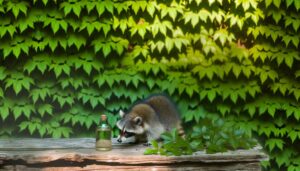Do Raccoons Live in Natural Habitats on the Ground?
Raccoons typically prefer nesting in trees, abandoned dens, or other above-ground locations rather than living directly in the ground. They exhibit a preference for wooded areas, utilizing their dexterous paws to forage and navigate diverse environments.
While raccoons may occasionally occupy burrows, they rarely dig their own, instead opting for abandoned ones that offer cover and proximity to food sources. Their adaptability allows them to thrive in both urban and rural settings, but tree habitats provide essential protection from predators and access to breeding sites.
For a deeper understanding of raccoon habitat preferences and behaviors, explore further.
Key Takeaways
- Raccoons rarely construct their own burrows, preferring to use abandoned dens.
- They favor locations that offer cover and concealment for nesting and foraging.
- Raccoons are more commonly found nesting in trees rather than in the ground.
- They exhibit selective preferences for burrows, particularly near food sources.
- Urban raccoons adapt to various environments, showing flexibility in habitat choices.
Raccoon Natural Behavior
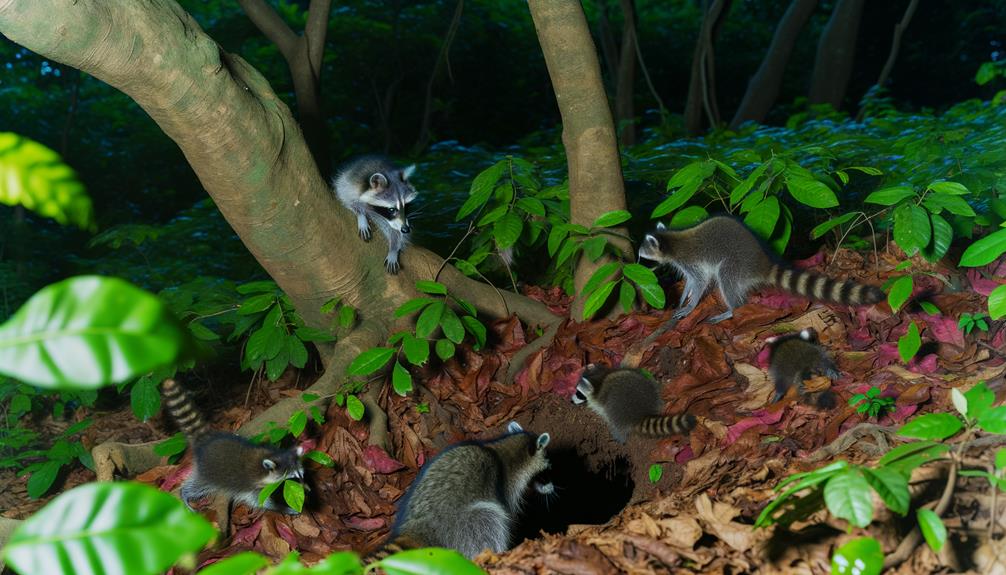
Raccoon natural behavior is characterized by their nocturnal activity patterns, omnivorous diet, and highly adaptable foraging strategies.
Mainly active during the night, raccoons exhibit a keen sense of touch, aided by their dexterous front paws, which allows them to manipulate various objects and access diverse food sources.
Studies indicate that raccoons consume a wide range of food items, including fruits, insects, small vertebrates, and human refuse, showcasing their dietary flexibility.
Their foraging behavior is opportunistic and strategic, enabling them to thrive in both wild and urban environments.
Evidence suggests that raccoons use cognitive mapping to remember food locations, enhancing their survival prospects. This behavioral adaptability underscores their resilience in fluctuating environmental conditions.
Common Raccoon Habitats
Inhabiting a variety of environments, raccoons are commonly found in deciduous and mixed forests, wetlands, suburban areas, and urban landscapes, demonstrating their remarkable ecological plasticity.
These adaptable mammals exhibit a preference for wooded areas where they can exploit trees for nesting and foraging. In wetlands, raccoons benefit from abundant food sources such as fish, amphibians, and vegetation.
Suburban settings provide ample opportunities for scavenging, often leading them to human dwellings. Moreover, urban environments, despite increased human activity, offer raccoons diverse food resources and shelter options.
This adaptability is supported by evidence showing raccoons' capacity to utilize various nesting sites, from hollow trees and burrows to abandoned buildings, showcasing their ability to thrive across diverse habitats.
Urban Vs. Rural Living
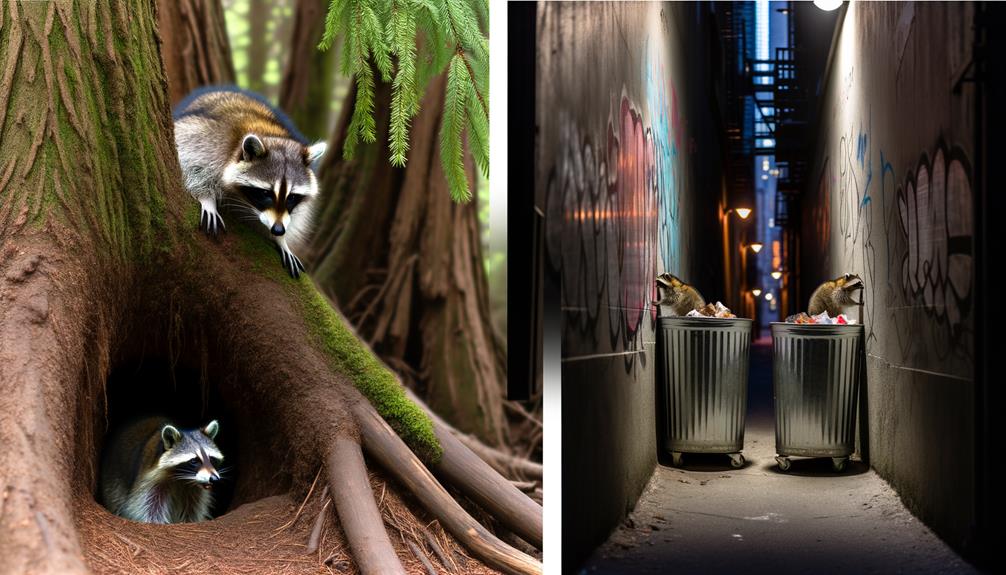
How do the environmental pressures and resource availability in urban areas compare to those in rural settings when determining raccoon behavior and adaptability?
Urban environments provide raccoons with abundant food sources through waste and human activity, leading to higher population densities and altered foraging behaviors. Conversely, rural areas offer natural food sources but require raccoons to cover larger territories to meet their nutritional needs.
Urban raccoons often exhibit bolder behaviors due to regular human interaction, while rural raccoons remain more cautious. Additionally, urban raccoons face unique challenges such as traffic and pollution, which can impact survival rates.
In both settings, raccoons demonstrate remarkable adaptability, leveraging available resources and modifying behaviors to thrive in diverse environments.
Raccoons and Burrows
Raccoons exhibit selective preferences when it comes to choosing burrows, often favoring abandoned dens created by other animals such as groundhogs or skunks. These burrows are typically located in secluded areas that provide both concealment and proximity to food sources, such as forests, fields, and sometimes urban greenspaces.
Research indicates that raccoons rarely construct their own burrows, relying instead on modifying existing structures to suit their needs.
Raccoon Burrow Preferences
Though raccoons are known to adapt to various environments, they frequently show a preference for burrowing in areas that offer both concealment and proximity to food sources.
Research indicates that raccoons select burrow sites based on several key factors:
- Cover and Concealment: Dense vegetation or structures provide protection from predators and harsh weather conditions.
- Food Availability: Proximity to abundant food sources, such as trash bins, fruit trees, and water bodies, is critical.
- Temperature Regulation: Burrows help in maintaining stable internal temperatures, shielding raccoons from extreme cold or heat.
These preferences are driven by raccoons' need for safety, sustenance, and suitable living conditions. Understanding these factors offers insight into their behavioral ecology and habitat utilization.
Typical Burrow Locations
Typical burrow locations for raccoons include hollow trees, abandoned animal dens, and human-made structures such as attics and sewers, all selected to optimize shelter and access to resources. Research indicates that raccoons exhibit high adaptability in choosing their habitats, often favoring areas that provide safety from predators and proximity to food sources.
Hollow trees offer natural insulation and concealment, while abandoned burrows of other animals provide ready-made shelters with minimal excavation required. Human-made structures, although unconventional, present raccoons with ample opportunities for scavenging and security. Urban environments, in particular, see increased raccoon activity in sewers and attics due to the abundance of food waste and limited natural predators.
This adaptability underscores the raccoon's resilience and opportunistic nature.
Tree Dwellers

While raccoons are often associated with ground burrows, their tree-dwelling activities are equally significant, showcasing their adaptability and preference for tree habitats in specific environments. Studies reveal that raccoons demonstrate a remarkable flexibility in choosing tree-based shelters, which serve multiple ecological functions:
- Protection from Predators: Trees provide elevated refuges that decrease susceptibility to ground-based predators.
- Access to Food Sources: Arboreal environments often offer a diverse range of fruits, nuts, and insects.
- Breeding Sites: Hollow trees and dense canopies provide ideal conditions for rearing young.
These behaviors underscore the species' ecological flexibility, enabling raccoons to thrive in different habitats. Understanding their tree-living tendencies is essential for thorough wildlife management and conservation strategies.
Raccoon Den Preferences
Raccoon den preferences exhibit considerable variability, with these animals selecting sites based on factors such as availability, safety, and environmental conditions. Research indicates that raccoons are opportunistic, often repurposing abandoned burrows, hollow trees, or man-made structures. High adaptability makes them resilient in diverse environments.
| Den Location | Emotional Impact |
|---|---|
| Abandoned Burrows | Sense of Resourcefulness |
| Hollow Trees | Connection to Nature |
| Man-made Structures | Coexistence with Humans |
| Rock Crevices | Survival in Harsh Terrain |
| Urban Areas | Adaptation to Change |
Their choice of den is influenced by predator presence, proximity to food sources, and climate. Such preferences highlight their intelligence and flexibility, enabling them to thrive in both rural and urban landscapes.
Seasonal Shelter Choices
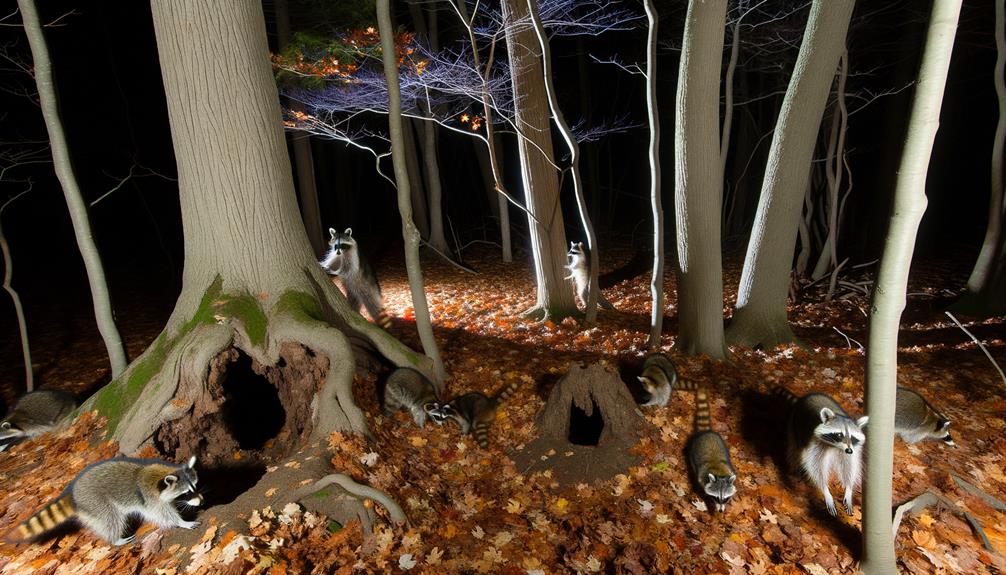
During colder months, raccoons exhibit distinct seasonal shelter preferences, often seeking out dens that provide enhanced insulation and protection from the elements. Scientifically, their choice of shelter is influenced by factors such as ambient temperature, food availability, and predator presence.
Evidence suggests that raccoons prefer:
- Tree Cavities: These natural hollows offer substantial insulation and are often elevated, reducing predator risk.
- Abandoned Burrows: Previously used by other animals, these underground shelters offer stable temperatures and protection from wind.
- Human Structures: Urban raccoons frequently utilize attics, chimneys, and basements, taking advantage of the consistent warmth and security provided by human homes.
Impact of Predators
Predation influences raccoon behavior and habitat selection. Natural enemies, including coyotes, bobcats, and large birds of prey, pose constant threats, necessitating robust defense mechanisms such as nocturnality and agile climbing abilities.
These adaptive strategies are critical for raccoons in mitigating predation risks and ensuring survival in various environments.
Natural Enemies of Raccoons
Facing a range of natural predators, raccoons have developed various adaptive behaviors and physical traits to enhance their chances of survival in the wild.
Their primary predators include:
- Coyotes: These agile mammals are adept hunters, capable of pursuing raccoons over varied terrains.
- Great Horned Owls: Possessing formidable hunting skills, these nocturnal raptors pose a significant threat, particularly to juvenile raccoons.
- Bobcats: As stealthy and powerful predators, bobcats target raccoons, especially in forested and rural areas.
These predators exert evolutionary pressure, influencing raccoon behavior and habitat choices. Studies indicate that raccoons often modify their foraging patterns and become more nocturnal to avoid predation.
Additionally, raccoons utilize arboreal habitats and den in tree cavities to evade terrestrial threats, showcasing their adaptive versatility.
Raccoon Defense Mechanisms
Understanding the impact of predators on raccoons necessitates an examination of the sophisticated defense mechanisms these animals employ to enhance their survival. Raccoons exhibit a range of adaptive behaviors and physiological traits that mitigate predation risks. One primary strategy is their nocturnal activity, which limits encounters with diurnal predators. Additionally, raccoons utilize arboreal habitats to escape terrestrial threats. Their acute sense of hearing and smell also play a crucial role in early predator detection. Moreover, raccoons can exhibit aggressive behaviors when cornered, including biting and scratching.
| Defense Mechanism | Description | Example of Predator Avoided |
|---|---|---|
| Nocturnal Activity | Active at night to avoid day hunters | Hawks |
| Arboreal Habitats | Climbing trees for safety | Coyotes |
| Acute Senses | Enhanced hearing and smell | Humans |
| Aggressive Behavior | Biting and scratching when threatened | Domestic Dogs |
| Camouflage | Blending into the environment | Bobcats |
These defense mechanisms underscore raccoons' resilience in predator-rich environments.
Human Interaction Effects
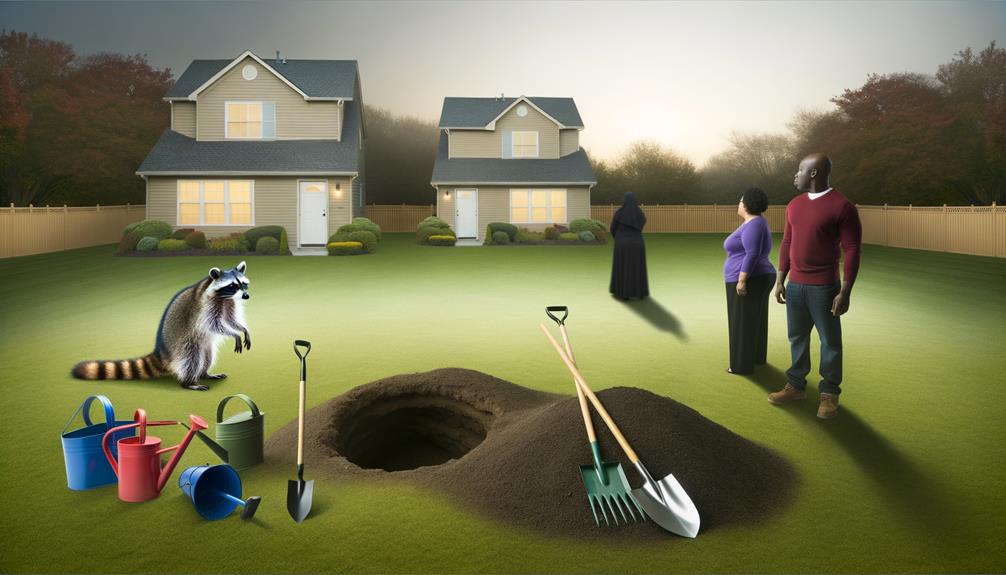
Human activities have greatly altered raccoon behavior and habitat selection, often forcing them to adapt to urban and suburban environments. These adaptable mammals exhibit significant changes due to human interaction, which can be categorized into three primary effects:
- Habitat Fragmentation: Urban development disrupts natural habitats, compelling raccoons to seek food and shelter in human-dominated landscapes.
- Resource Availability: Increased access to anthropogenic food sources like garbage and pet food encourages raccoons to frequent urban areas, altering their natural foraging habits.
- Human-Wildlife Conflict: Close proximity to humans heightens the risk of conflicts, such as property damage and the spread of zoonotic diseases.
Studies indicate that these changes can lead to behavioral adaptations, impacting raccoon population dynamics and ecosystem roles.
Misconceptions Debunked
Contrary to popular belief, raccoons do not typically live in the ground but instead prefer elevated shelters such as hollow trees, attics, and abandoned buildings.
Research indicates that raccoons seek out these elevated habitats to avoid predators and gain a vantage point for foraging.
A study conducted by the University of Georgia revealed that 60% of raccoon dens are located above ground, highlighting their preference for height.
Additionally, raccoons are excellent climbers, which enables them to access these elevated refuges easily.
While ground burrows are occasionally used, particularly in harsh weather conditions, they are not the primary choice.
Understanding these habitat preferences is essential for managing raccoon populations and mitigating human-wildlife conflicts effectively.
Conclusion
Raccoons, adaptable creatures of the night, exhibit a dynamic range of habitat preferences, from urban alleyways to rural woodlands. They are known to exploit various shelters, including burrows, tree cavities, and human-made structures.
Seasonal shifts and predator presence influence their shelter choices, with urban environments providing unique interactions and challenges. Misconceptions about their living habits are debunked through detailed analysis, revealing a species adept at maneuvering diverse landscapes and adapting to multifaceted environmental pressures.




